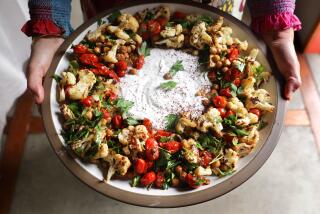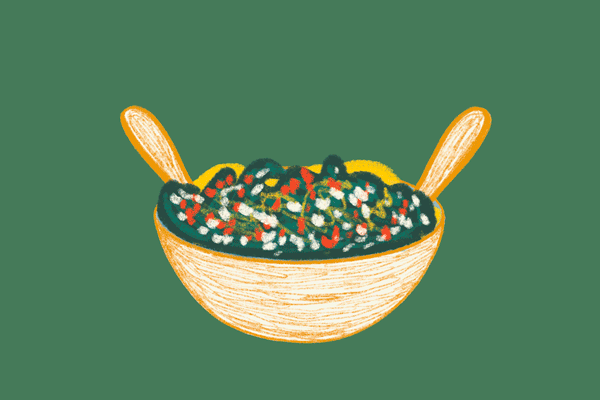How I Became a Beet Crusader
- Share via
Beet lovers are made, not born.
Actually, maybe they’re remade. Although we may come into the world with blank tablets for palates--ready to embrace almost any food that comes along--there are some things we’re cured of very early.
Beets are among them. The reason is easy to understand: those horrible canned beets that bad cooks scatter across plates for the sole purpose of “providing color.”
In this way, the poor beet is reduced to nothing more than a kind of red parsley: essentially inedible on its own but nonetheless ubiquitous in the hands of a certain kind of cook. In my mind, I picture canned beets served with canned asparagus alongside gray, overcooked lamb.
This is a shame. Properly prepared beets are among the most distinctive and delicious of vegetables. Rather than pallid, slightly bitter things drowned in cheap vinegar, good beets are miraculously sweet with a fine mineral quality almost like a great Burgundy. (Note to wine geeks: Think of a dark, concentrated Cote de Nuits rather than a lighter, sunnier Cote de Beaune.)
The education of a beet eater, then, is really a process of re-education. My own epiphany came several years ago. Taking a drive along the Palos Verdes peninsula, I stopped at the little flower and vegetable stand called Annie’s, just above Abalone Cove. Why I bought the beets from owner James Ishibashi I can’t say. But when I got them home, I roasted the roots and blanched the tops and combined them in a salad with good olive oil and sherry vinegar.
They were shockingly delicious, and I could have eaten all of them by myself. I simply couldn’t imagine how something that tasted that good had been available for so long without my enjoying it.
I quickly set about making up for lost time. For a couple of years, I served beets over and over to as many people as I could. “Try this,” I would say, forcing yet another plate of beet salad on them. “You won’t believe it.”
Finally, that grew as tiresome for me as it was for everyone else. Now, I’ve cut back to four or five times every winter. And maybe as many in the spring when tiny new beets come along--the ones you can eat whole. Come to think of it, they are good in fall too--as soon as the heat is off. But never in summer, unless, of course, I feel like it.
The secrets to good beets are simple. First, start with good produce. The best way to tell if beets are fresh is by looking not at the roots but at the tops. The greens are much more fragile and will show wear and tear more quickly. They should be a vibrant green with no soft wilted spots. Avoid roots without tops or those with new growth sprouting, a sign that the beets have been held too long. When you see that, it’s not a beet day. Buy turnips, rutabagas, asparagus . . . anything else.
The biggest trick, though, is in the cooking. Perhaps more than with any other root vegetable, roasting is the key. It deepens and concentrates the flavor in a marvelous way. To roast beets, trim the greens about an inch above the ball and leave the spindly root attached (beets will bleed through any cut surfaces). Wrap all of the beets together in one layer in a foil package, put them on a baking sheet and roast them at 350 degrees. Turn once after about half an hour to keep them from scorching. They’ll be done in about an hour. You can tell when a knife (inserted through the foil) slides into the beet without resistance.
Peel, slice and season them as soon as they’re cool enough to handle. (They’re easy to peel--the skin will slip right off, leaving glossy beet meat behind.) As with potatoes, the warmer the vegetable is when it’s seasoned, the more it absorbs flavorings. Some of my favorite flavorings with beets are horseradish and garlic.
Those flavorings, or rather the balance of those flavorings, is what makes a recipe like Beet and Orange Salad work. The taste of the horseradish should not be noticeable. Instead, it should be a background taste that adds complexity to the flavor of the beets. The same is true of the garlic.
The trick here is to keep an open mind and keep trying. Dip scraps of orange and beet together in the dressing, then taste that and adjust the seasoning. The final mix will improve the flavors of the beets and the oranges and provide a bridge between the two. You’ll know it when you taste it.
Keep tasting until you get it right. Honest, even though these are beets, they won’t hurt you.
BEET AND ORANGE SALAD
6 beets, with tops
3 navel oranges
4 teaspoons prepared horseradish
1/4 teaspoon minced garlic
2 tablespoons red wine vinegar
6 tablespoons olive oil
Salt, pepper
1 tablespoon lemon juice
2 tablespoons chopped toasted pecans
Trim beet tops to within 1 inch of beets and reserve tops. Leave roots intact. Wrap beets in foil and bake at 350 degrees, turning once, until small knife can be easily inserted, about 1 hour. Set aside until cool enough to handle.
Peel oranges, removing all white pith. Working over bowl to catch any juice, carefully separate each orange section from main membrane by cutting down both sides of section between flesh and membrane and gently scooping flesh away from membrane. Place each cleaned section in bowl with juice. When finished, squeeze juice from main membrane into bowl and discard membrane. Reserve juice.
Blanch reserved beet greens in large pot of boiling water just until color brightens and stems become tender, about 1 minute. Remove immediately to bowl of cold water to stop cooking. Drain well and dry on kitchen towel.
When beets are cool enough to handle, slide peels off with your fingers. Remove remaining part of tops and trim roots, reserving scraps. Slice beets into rounds 1/4-inch thick.
Make salad dressing by whisking together horseradish, garlic, vinegar and reserved orange juice in bowl. When smooth, slowly add olive oil, beginning with just a thread. When all oil is added, season to taste with salt and plenty of black pepper. If necessary, add a little horseradish, lemon juice or more oil to correct acidity. (Test by dipping orange section and piece of beet root into dressing. Flavor should be bright but well-balanced.)
Add sliced beets to dressing, toss well and arrange in low mound in center of platter, leaving behind any extra dressing. Add orange slices to dressing, toss well and arrange over top of beets. Add greens, toss well and arrange around outside of beets. Sprinkle with toasted pecans.
6 servings. Each serving:
192 calories; 110 mg sodium; 0 cholesterol; 14 grams fat; 17 grams carbohydrates; 2 grams protein; 0.96 gram fiber.
More to Read
Eat your way across L.A.
Get our weekly Tasting Notes newsletter for reviews, news and more.
You may occasionally receive promotional content from the Los Angeles Times.











